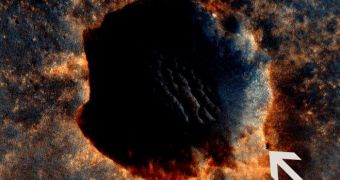A NASA orbiter flying in low-orbit above the Red Planet has recently captured a set of images showing one of the twin rovers the American space agency operates on Mars. The vehicle is currently perched on the rim of a crater, conducting geological research.
This photo also reveals the tracks that Opportunity – a component of the Mars Exploration Rover (MER) mission – made while approaching its current location. The robot is investigating the Santa Maria crater, a 295-foot (90-meter) opening in the ground.
But this is not its final destination. Opportunity has spent the past three years heading for the Endeavor crater, a massive dent in the Martian surface that mission scientists are convinced would justify the costs of the MER project all by itself.
But the 14-mile (22-kilometer) wide crater is still far away for the rover's small wheels. The robot set out to reach it in August 2008, and will probably need at least one or two years to reach its target.
In the meantime, it's making a lot of stops along the way, imaging meteorites it encounters on the surface, interesting rock deposits and outcrops, as well as smaller craters. Santa Maria is one of them.
Opportunity has been perched on its rim collecting data assiduously for the past three months, as mission controllers clearly felt that the scientific return would justify the delay in reaching Endeavor.
The rover's current target is Ruiz Garcia, an interesting rock that it's analyzing via the abrasion tool and spectrometer on its robotic arm. Scientists with the Jet Propulsion Laboratory (JPL), in Pasadena, California, have also instructed the machine to take close-up photos of the meteorite.
As the machine was engaged in such investigations, the NASA Mars Reconnaissance Orbiter (MRO) flew overhead on March 1, and collected the new photos. They show the rover clearly visible in the midst of rugged terrain at this area of Mars.
The orbiter used its High Resolution Imaging Science Experiment (HiRISE) instrument to take the images. This is the most powerful camera ever sent to space to study another moon or planet.
It was no problem for this instrument, which can see things as small as a coffee table from its orbital vantage point, to see Opportunity, which is about the size of a gold cart. Squint hard enough, and you can even see details on the rover.
But the enthusiasm the JPL team had on seeing these images was somewhat tempered by the fate of Opportunity's twin rover, Spirit. The machine is stuck in a patch of loose Martian sand called Troy.
It was caught in it in 2009, and the JPL team spent nearly a year trying to get it out. Then the Martian winter came, and the rover went silent. Now spring has come at its location, and yet there are still no signs of awakening from it.
Both rovers were designed to explore Mars for three months, but that was back in 2004. Each of them surpassed its guarantee several times over, carrying out the job of 20 or 25 other individual missions, Space reports.

 14 DAY TRIAL //
14 DAY TRIAL //